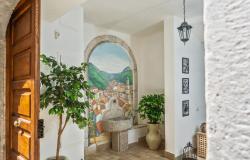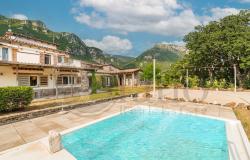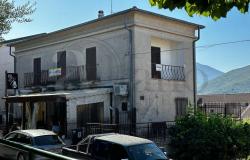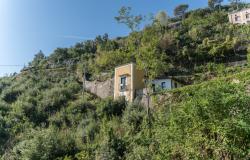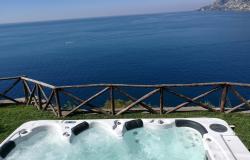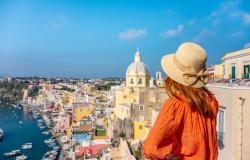Almost everyone knows that the Roman city of Pompeii was destroyed by an eruption of Mount Vesuvius, and that its superbly preserved remains have been revealed by archaeologists.
What is less well-known is that this eruption, on 2nd August 79AD, destroyed several other cities around the Bay of Naples. Herculaneum was one of those cities, but while Pompeii was buried beneath what was mostly lava, Herculaneum was covered by volcanic mud.
In the early 18th century, an Austrian army officer had a well dug here and came upon part of the theatre, that Herculaneum was rediscovered. Intermittent excavations followed in the time of Mussolini, resulting in the exposure of a good part of the Roman town.
Writing of Philodemus
 In academic circles, Herculaneum is especially famous for the ‘Villa of the Papyri’, from which rolls of papyrus were recovered by the early excavators. Modern techniques allowed many to be unravelled and read, leading to the discovery that many are the original writings of an Epicurean philosopher called Philodemus who lived here.
In academic circles, Herculaneum is especially famous for the ‘Villa of the Papyri’, from which rolls of papyrus were recovered by the early excavators. Modern techniques allowed many to be unravelled and read, leading to the discovery that many are the original writings of an Epicurean philosopher called Philodemus who lived here.
A town called Ercolano, the modern Italian version of the name Herculaneum, now covers the area. Ercolano is within the Naples conurbation, which has spread out to the footslopes of Vesuvius, and is served by the Circumvesuviana railway, which runs from Naples around the volcano to Sorrento and Poggiomarino.
Ercolano has two stations, and you need to get off at ‘Ercolano Scavi’ (literally ‘Herculaneum excavations’). From the station, head downhill towards the coast and you can’t miss the site.
One word of caution. Please do not visit expecting to see a complete Roman town. What you will see is spectacular enough, but only part of Herculaneum has been exposed (not the Villa of the Papyri, for instance).
The buildings suffered damage in the original eruption, and those that have been excavated from the mud that preserved them are now open to the elements. Having passed the admission gates of the site, I walked over a bridge where I had my first impressions.
There were good views of the Roman remains, but the part of the site below the bridge sounded a note of caution, for it looked neglected and overgrown.
You also see Mount Vesuvius, the cause of all the trouble and still bearing the scars of the eruption of AD79, looming above the place. From here it is all too easy to imagine the fear of the Roman inhabitants as they faced that sudden eruption, and how easily that emotion could reoccur today if the event were to be repeated on the same scale.
Through the Tunnel
 Having seen the site clearly, it was then a surprise to follow the ‘entrata’ sign and to find myself heading down a long sloping tunnel that descends through the hardened volcanic mud. However, the tunnel is a fine idea, for it gives the visitor a sense of the material that once buried the whole site.
Having seen the site clearly, it was then a surprise to follow the ‘entrata’ sign and to find myself heading down a long sloping tunnel that descends through the hardened volcanic mud. However, the tunnel is a fine idea, for it gives the visitor a sense of the material that once buried the whole site.
It was wonderful to see how well the site had been preserved. You can walk along Roman streets that are flanked by Roman buildings, many complete to roof level. You walk inside some and see household features and decorations which are not in fragments in some museum case, but complete and in their original places. The wall paintings alone are well worth the visit. It is an extraordinary feeling to be walking through the house (intact except for a few holes and modern doors or bits of glass) of someone who lived nearly 2,000 years ago, particularly when you start to wonder if that person was killed in the ensuing disaster.
The wall paintings alone are well worth the visit. It is an extraordinary feeling to be walking through the house (intact except for a few holes and modern doors or bits of glass) of someone who lived nearly 2,000 years ago, particularly when you start to wonder if that person was killed in the ensuing disaster.
A part of the site that is actively conserved is the Trellis House, which is in good condition with a modern timber roof and balcony that give a fair impression of original features lost in the eruption.
The problem is really that there is just too much to conserve properly. The excavators, particularly those in the early 20th century, must have been keen to dig and to put as much of Herculaneum on show as possible, but they gave little thought to the problems this would cause and how such a site can be displayed for only a few decades before decay becomes a major problem.

